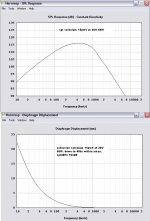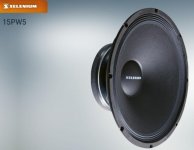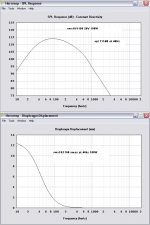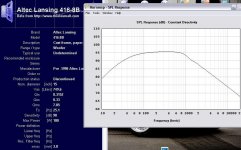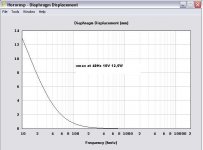I'm almost scared to ask this questions😀
Once again I having trouble getting my brain around something, this time it's Qts.
Can anyone explain in laymans terms what the difference is between a high Qts driver & a low qts driver, ie bigger magnets? softer suspension, more electrical force etc
Why are high Qts drivers better for OB?
What will happen if you use a very low Qts driver?
D
You can start by reading this one
OBriggs
then this
Quarter Wavelength Loudspeaker Design
B.L
What term would you suggest for the wave reflected off the impedance discontinuity at the H frame's mouth? At 30cm the round trip time of flight's about 2ms, right around the threshold where early reflections are no longer percieved as part of the initial wavefront, so I agree it's unlikely one would hear it as a distinct honk.Nothing is honking here with a shallow H frame of 30cm. The first thing you would hear are floor vibrations and turbulences from the driver basket.
They're not necessarily better. In free air (nude dipole, though the basically the same applies to baffled dipoles) most cone woofers exhibit a second order rolloff in SPL below Fs. Qts describes the transition from the "flat" SPL above Fs to the rolled off SPL below Fs. Qts 0.7 is the only transition between the two domains which keeps the SPL flat above Fs. Qts below 0.7 is a slower transition where the driver starts to roll off above Fs; the lower the Qts, wider the transition band in frequency and the greater the bass rolloff. Qts above 0.7 is a faster transition where the SPL peaks around Fs; the higher the Qts the narrower the transition band and the higher the peak. Drivers of Qts around 0.7, such as the Eminence Alpha 15A, are popular in free air applications with limited equalization capabilities as in theory they produce the flattest SPL. In practice driver manufacture is often not very precise and there can be considerable variation in T/S parameters from part to part so, depending on driver selection, one can end up doing a certain amount of guesswork. Also, Qts tends to vary inversely with excursion and drivers are usually operated below the 10% rated power where datasheet Thiele-Small parameters are (usually) taken. So the Qts in the driver's typical operating range tends to average higher than spec but that may or may not be the case for the driver you get.Why are high Qts drivers better for OB? What will happen if you use a very low Qts driver?D
For passive or analog active crossovers it's probably therefore preferable to select Qts more around 0.5 or 0.6 as the use of EQ beyond dipole compensation is uncommon in such situations. With EQ---typical of digital crossovers, though there's no reason you can't do it in analog---this constraint's removed and it may be desirable to choose low Qts to get better efficiency in the deep bass or around the lower end of the driver's passband. That choice mainly depends on how the driver's distortion varies with excursion and how equalization for dipole rolloff is done. In most cases I would select pro woofers based on xmax first and worry about Qts second as getting a couple extra dB around Fs is kind of pointless if the distortion's high.
Printed ready for some bedtime reading.
..you should consider this:
2 of these (per side):
SW-12-08 - SW-12-08
Powered by one of these (per side):
H600PEQ - H600PEQ
You can see their "orion'esq" model here:
http://www.audiocircle.com/index.php?PHPSESSID=g19u819qn27qdmf19a2l9e3d8f9q143t&topic=72093.0
2 of these (per side):
SW-12-08 - SW-12-08
Powered by one of these (per side):
H600PEQ - H600PEQ
You can see their "orion'esq" model here:
http://www.audiocircle.com/index.php?PHPSESSID=g19u819qn27qdmf19a2l9e3d8f9q143t&topic=72093.0
They're not necessarily better. In free air (nude dipole, though the basically the same applies to baffled dipoles) most cone woofers exhibit a second order rolloff in SPL below Fs. Qts describes the transition from the "flat" SPL above Fs to the rolled off SPL below Fs. Qts 0.7 is the only transition between the two domains which keeps the SPL flat above Fs. Qts below 0.7 is a slower transition where the driver starts to roll off above Fs; the lower the Qts, wider the transition band in frequency and the greater the bass rolloff. Qts above 0.7 is a faster transition where the SPL peaks around Fs; the higher the Qts the narrower the transition band and the higher the peak. Drivers of Qts around 0.7, such as the Eminence Alpha 15A, are popular in free air applications with limited equalization capabilities as in theory they produce the flattest SPL. In practice driver manufacture is often not very precise and there can be considerable variation in T/S parameters from part to part so, depending on driver selection, one can end up doing a certain amount of guesswork. Also, Qts tends to vary inversely with excursion and drivers are usually operated below the 10% rated power where datasheet Thiele-Small parameters are (usually) taken. So the Qts in the driver's typical operating range tends to average higher than spec but that may or may not be the case for the driver you get.
For passive or analog active crossovers it's probably therefore preferable to select Qts more around 0.5 or 0.6 as the use of EQ beyond dipole compensation is uncommon in such situations. With EQ---typical of digital crossovers, though there's no reason you can't do it in analog---this constraint's removed and it may be desirable to choose low Qts to get better efficiency in the deep bass or around the lower end of the driver's passband. That choice mainly depends on how the driver's distortion varies with excursion and how equalization for dipole rolloff is done. In most cases I would select pro woofers based on xmax first and worry about Qts second as getting a couple extra dB around Fs is kind of pointless if the distortion's high.
Thank you very instructive🙂
So what xmax would you recommend?
Last edited:
In this picture Q of a system and roll off. Q of 0.7 is seen as most flat blackline.
But 0,5 up to 1.2 can also be acceptable depends on what design goals are important to the designer.
But 0,5 up to 1.2 can also be acceptable depends on what design goals are important to the designer.
An externally hosted image should be here but it was not working when we last tested it.
Last edited:
Thank you very instructive🙂
So what xmax would you recommend?
When you simulate you can see what spl you will get at given power and the xmax the driver makes.
So your xmax depends on how loud and low you want to play.
Loud and low means big Sd and xmax.
A 15" with 5mm will be enough when you use two like i caculated for you with the linkwitz sls driver. It is about how much air the driver can move Sd*xmax and then with the right Q to have a flat response.
Last edited:
What Helmuth said, though you probably want to get more specific about SPL, distortion targets, and baffle size before doing a go-no go on 2x 15@5mm. My pro woofer suggestions are earlier in the thread.So what xmax would you recommend?
Here the result of the selenium 15pw5. with a xmax of 5,7mm. With two drivers you can ad 3dB to the spl.
http://www.selenium.com.br/site/assets/produtosfinal/246_pdfManual.pdf
http://www.selenium.com.br/site/assets/produtosfinal/246_pdfManual.pdf
Attachments
Last edited:
High Qts drivers are popular for open baffle applications because the bump in response at FS helps to counter the open baffle rolloff and extends the low frequency response.
That only applies to passive systems, however. With EQ it's easy to boost the low frequency response and there is no real benefit to high Qts.
That only applies to passive systems, however. With EQ it's easy to boost the low frequency response and there is no real benefit to high Qts.
prices
Amazon.com: Selenium 15PW5-SLF 15" 350W PA Driver: Electronics
The more desirable sws18/1100 is even cheaper compared to two 15pw5. And the sws18 is 6dB louder at the same power 100W. This means that two 15pw5 need 400W together, to make the same spl at 40Hz.
Selenium 18SWS1100 Car Speaker - Car Speakers and Subwoofers - Product Reviews and Prices - Shopping.com
Amazon.com: Selenium 15PW5-SLF 15" 350W PA Driver: Electronics
The more desirable sws18/1100 is even cheaper compared to two 15pw5. And the sws18 is 6dB louder at the same power 100W. This means that two 15pw5 need 400W together, to make the same spl at 40Hz.
Selenium 18SWS1100 Car Speaker - Car Speakers and Subwoofers - Product Reviews and Prices - Shopping.com
Attachments
Last edited:
High Qts drivers are popular for open baffle applications because the bump in response at FS helps to counter the open baffle rolloff and extends the low frequency response.
That only applies to passive systems, however. With EQ it's easy to boost the low frequency response and there is no real benefit to high Qts.
And not only to active systems.An open baffle speaker placed at some specific distance from the nearest boundaries,design specifics prevail,will overcome a low Qts, 6db/octave loss,without equalization.Listening space,is the main component that a system must be tuned to.
B.L
The sim of 416 above looks pretty good. What's the condition?
[edit] Oh, you just posted when I was typing.
[edit] Oh, you just posted when I was typing.
It seems my desire to have two 12" is a lost cause😕 I'll see if I can come up with an aesthetic design I like that incorporates, two x 15 or 1 x 18".
The aesthetics are very important to me, even though I dont have to worry about the WAF. I cannot live long term with speakers I dont like the look of, especially if I have built them.
Obviously I dont want to comprimse the sound quality for the looks, it's just finding a good combination of the two.
Maybe I could use the 12"s then add a sub to fill in the bottom end, althought that seems like a compromise & from what Iv'e read hard to get a seamless fit.
The aesthetics are very important to me, even though I dont have to worry about the WAF. I cannot live long term with speakers I dont like the look of, especially if I have built them.
Obviously I dont want to comprimse the sound quality for the looks, it's just finding a good combination of the two.
Maybe I could use the 12"s then add a sub to fill in the bottom end, althought that seems like a compromise & from what Iv'e read hard to get a seamless fit.
It seems my desire to have two 12" is a lost cause😕
perhaps you didn't read my post? 😉
The sim of 416 above looks pretty good. What's the condition?
[edit] Oh, you just posted when I was typing.
2phi is estimated to be close to the floor.
The baffle that you did design can easy hide a 18" behind is and then it is not a big problem to keep the opening for the cone 12" wide and 18" high. So what concerns dimensions you do not have to change your design.It seems my desire to have two 12" is a lost cause😕 I'll see if I can come up with an aesthetic design I like that incorporates, two x 15 or 1 x 18".
The aesthetics are very important to me, even though I dont have to worry about the WAF. I cannot live long term with speakers I dont like the look of, especially if I have built them.
Obviously I dont want to comprimse the sound quality for the looks, it's just finding a good combination of the two.
Maybe I could use the 12"s then add a sub to fill in the bottom end, althought that seems like a compromise & from what Iv'e read hard to get a seamless fit.
Correction maybe make the opening wider 11-14 inch. Or make the opening round where the woofer is located.
Designing is often about making compromises DQ828.
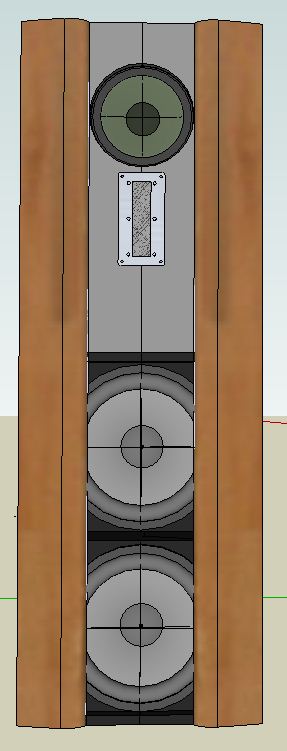
An externally hosted image should be here but it was not working when we last tested it.
Attachments
Last edited:
perhaps you didn't read my post? 😉
Yes I read your post & perhaps I was being a bit melodramatic saying using two 12" was a lost cause. Your suggestion are very valid, but are also a long way from my goals, being, a hi efficiency, passive design, the tweeter is about 96dB & the mid is somewhere closer to 100dB, or so I have read.
I dont want to get involved in an active design at this early stage of speaker building hobbie. Also I aleady have the amp etc.
If you know of any hi efficieny, 12" drives with a Qts of about 0.7 & a xmax of 6+ let me know, all suggestions are welcome.
- Status
- Not open for further replies.
- Home
- Loudspeakers
- Multi-Way
- OB Project Design Started, Help Requested.
